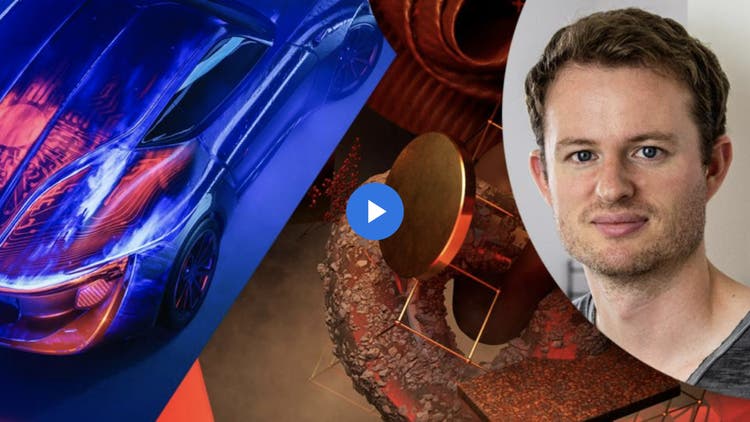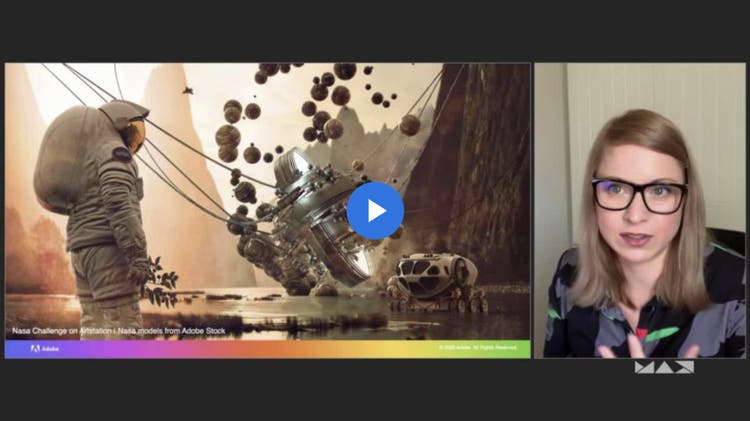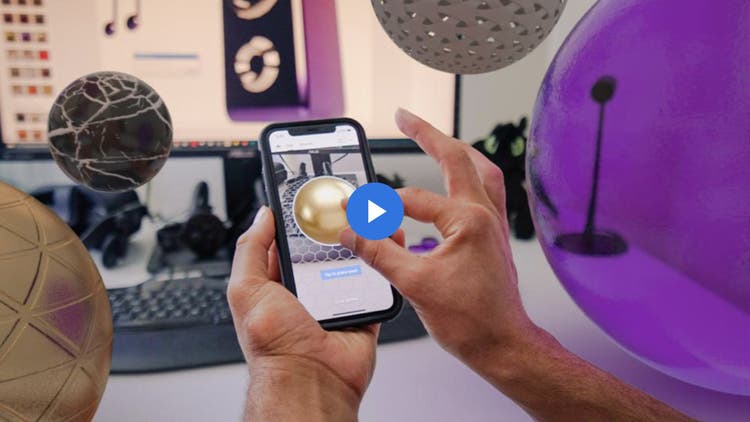How 3D and AR will transform creative design in 2021

The latest advancements in 3D and augmented reality (AR) are nothing short of mind-blowing. We now have the tools to create futuristic worlds and designs that are so realistic that you can hardly tell that they’re indeed digital creations. That in itself may not be so surprising, as we’re used to technology moving at a dizzying pace; however, 3D and AR tools are no longer niche, and the tools are no longer only accessible to large companies and studios. Creatives can now take advantage of a varied and affordable toolset that enables them to really push the boundaries, liberating them to work wherever they like at the same time.
The first-ever virtual edition of Adobe MAX, held in October 2020, therefore placed a big focus on 3D and AR. There was an entire track of sessions dedicated to interactive, immersive design (still available to watch for free now), and many exciting announcements, including the release of the Adobe Aero desktop app (currently in beta), as well as sneaks into future technology that the Adobe research team is working on (check out Material World and Scantastic).
To find out where 3D and AR are headed in 2021, we spoke to three artists and Adobe MAX speakers who work in this cutting-edge field.
Realistic worlds created on a single computer
Technology has moved on so much recently that it’s now possible to create innovative and extremely realistic augmented reality graphics as well as 3D and AR designs without a large team. It enables artists to set up their own one-person freelance practices and facilitates closer collaboration. It also means that instead of arranging costly and time-consuming traditional photoshoots, which are on hold during the pandemic, companies can pivot to the creation of 3D-generated photorealistic images.
The work of Ronan Mahon and Anna Natter are perfect examples of just how much this technology empowers creatives these days.
Ronan Mahon: High-end 3D digital materials with Substance by Adobe
Freelance artist Ronan Mahon went solo after over a decade of creating 3D worlds for leading game studios. Maturing technology enabled him to create his stunning cinematic videos and motion graphics completely on his own.
“The computer and software I have are now almost as powerful as a whole studio,” he explains. “I love that I can have an idea and bring it to life from the comfort of my home in the Bavarian countryside. I’m able to create a wide range of concepts from start to finish — whether it’s an illustrated poster or a 4K motion graphics video for a client.”
A look back at the projects Ronan created in collaboration with the Adobe Substance team in 2020.
As soon as Ronan discovered 3D, he fell in love with the ability to explore his work from different angles. It makes a design more present and enables viewers to discover new layers.
Thanks to the Substance 3D suite of 3D texturing tools, visualizing design concepts in a photorealistic way is now becoming common practice.
“I’ve recently worked with the team behind the digital material library, Substance Source to design and visualize a fictional lineup of products,” Ronan reveals. “We treated the project as a real-world production with all the considerations and steps you would expect. At the end of the process, we could really imagine the products in our hands. It’s pretty amazing that I never met the rest of the team. We all come from diverse backgrounds and yet can collaborate in this fashion.”

Ronan’s collaboration with Substance demonstrates the freedom of digital product and material design.
Ronan says it’s staggering how far the technology has come over the last few years. Seeing his work in VR for the first time was a bit of a shock.
“It has a presence and reality that I’ve never experienced before,” he points out. “Having the creative skills and ability to tap into this technology, while working remotely, and deliver consistently in the tough environment we find ourselves in at the moment, gives me the confidence that the risk I took to start my own studio was the right decision. I’m now being approached by other industries to work on art installations and even music concerts.”
In his session at Adobe MAX, Ronan Mahon shared his work and path as an independent 3D motion graphics artist.
Anna Natter: Complex 3D projects in Adobe Dimension
Freelance senior graphic designer Anna Natter (read our recent profile) trained as a traditional 2D animator and started out on a news graphics team in the television industry. She is blown away by the fast pace 3D and AR technology is evolving at.
“Nowadays it’s not surprising anymore that you can walk around an AR project with your phone or use a mobile app to turn a picture of tree bark into a well-functioning 3D material within 20 seconds,” Anna explains. “Technically, you can achieve pretty much anything with 3D now, which is why there is more and more need for 3D design. It’s about to become the ‘new normal’.”
Anna has been obsessed with 3D from the very first moment she tried out 3D design software. Three years ago she decided to learn 3D with Adobe Dimension, which made the technology accessible to her. It allowed her to create in a completely new way, expanded her skillset, and led to a career as a 3D digital artist.

An art print entitled “Heritage”, created by Anna Natter with Adobe Dimension.
Now tools are more affordable and user-friendly than ever. Playing around with different apps makes creating fun, and that didn’t stop when COVID-19 suddenly forced everyone to work from home. In fact, it brought the community closer together.
The Facebook group that Anna created, Adobe Dimension Enthusiasts, which has 1.7k members and counting, became a virtual meeting room for everyone interested in the tool. The sharing options in Creative Cloud Libraries, meanwhile, boosted collaboration.
“It’s great for connecting with other people, like my group, or sharing work with colleagues,” Anna points out. “It makes life so much easier, and I actually see more collaboration between digital artists. We are kept apart but are somehow closer than before.”
At Adobe MAX, Anna Natter spoke about her life-changing journey from 2D to 3D with Adobe Dimension.
Creativity pushed to the max with increased control
Sophisticated 3D and AR tooling opens up whole new possibilities for the creation of immersive experiences. By making use of all the different apps at their disposal — the new Aero desktop app, Medium, Substance Painter, Dimension, and more — creatives can push their imagination to the limits.
Read on to find out how digital artist Don Allen III harnesses 3D and AR tools to create his mind-bending futuristic worlds.
Don Allen III: Combining 3D and AR tools for immersive XR experiences
For DreamWorks Animation specialist trainer Don Allen Stevenson III (see our previous report) three technological advancements have really upped the game for 3D in AR:
- Mobile phones are finally powerful enough to handle the data required for quality 3D AR creations.
- Mature AI technology now ensures computers can accurately see the environment and understand planes and surfaces, which enables the tracking and visualization of footage in real-time.
- The integration of easy-to-use procedural animation tools means designers can quickly animate and iterate on their ideas with the combination of triggers, behaviors, and actions.
As a result, the time it takes to go from an idea to visual concept has vastly decreased.
“The tools are making it so much easier to focus on the creating part and less on the technical stuff,” Don explains. “As they’re also more user-friendly, it lowers the barrier to entry. In the near future, I believe the content that can be made with real-time tools will match and eventually surpass what’s currently only possible by rendering overnight.”

In 2020, Don released a series of interactive AR experiences, created with Adobe Aero, all centered around the theme of brain development.
As Don’s internet connection can be weak, he likes being able to test the 3D rigging of his animation and character design locally on the new Aero desktop app, which saves him a lot of time. The app, which allows for much deeper precision and more complexity, also enables him to see textures.
“I still struggle to match textures created in Substance Painter on AR platforms,” he points out. “Aero helps me to instantly assess them, so I know what they’re going to look like. I also like all of the alignment tools that come with the desktop app and am especially thrilled about the support for QR codes because I plan on utilizing them in crypto art that I’m publishing on the blockchain.”
In 2021, Don is looking forward to using a new end-to-end workflow facilitated by the integration of Adobe Capture in Aero. It’ll soon be possible to create high-resolution 3D scans of objects in Capture, send them to Dimension for texturing and layout and back to Aero to view them and create AR interactions.
“That workflow will really help people break the rules of the physical versus digital art and creativity space,” Don believes. “I also hope that the AR formats will start to converge, so that I can use Aero to collaborate with other clients and creatives in the extended reality (XR) space. I believe that we are going to start valuing virtual assets like physical ones soon, so being able to display digital art in a physical space is going to be more and more relevant.”
At Adobe MAX, Don Allen Stevenson III demonstrated how he uses Adobe Aero, Dimension, Medium, and Substance Painter to craft mind-bending immersive experiences for personal and professional use.
Powerful and fast material creation
Adobe’s research team showcased two jaw-dropping experimental technologies at MAX:
- Project Material World uses AI to convert pictures into digital materials — even photos taken with a smartphone
- Project Scantastic digitizes real-world objects into 3D assets, using nothing but a mobile device
“Material creation can leverage capture methods to enable users to design photorealistic 3D objects by starting from a real sample,” Tamy Boubekeur, director of 3D&I research for Adobe, explains the idea behind Project Material World. “We wanted to provide the user with the simplest possible capture experience: taking a single photo of a real material and obtaining a realistic material model in just a few seconds.”
Project Material World makes use of neural nets, trained on procedurally augmented data, and various optimization techniques. As a result, users can now simply drag and drop pictures in Substance Alchemist to turn them into realistic, usable materials.
“Injecting the real world into digital experiences opens up many possibilities for the creative industries,” Tamy points out. “It makes the design process shorter, allows the blending of real and synthetic content in AR or to preview potential variations of real assets, and it lowers the bar to enter 3D creation. Users can edit — rather than recreate — complex objects and mix and match existing content to make new artifacts.”
Tamy believes that empowering users with advanced technologies that are driven by machine learning has two very positive outcomes.
“First, automation does not limit creativity but tends to enhance it,” he explains. “It frees up users to spend more time on the creative aspects. Second, advanced technologies do not require advanced users. It’s quite the opposite: more creatives, with various backgrounds, are now able to produce 3D artifacts, not only CG experts. I believe we are entering a golden age of computer graphics, with much more diversity in the creations than ever before.”
Project Material World provides an intuitive material identification process, working under natural lighting, without the need for complex capture setups or user inputs.
The future of design is 3D and AR
In 2021, we will continue to see the democratization of immersive technologies. Creatives new to the field can smoothly incorporate 3D and AR into their work and have access to a wide range of user-friendly, intuitive tools wherever they are.
Professionals, meanwhile, will combine all the different apps to create even more complex and precise innovative experiences, pushing the limits of what’s possible. No longer seen as emerging technologies, 3D and AR are now becoming the norm and will be ubiquitous in the months ahead.


